 |
||
|
||
| ||
Since 1982, when IBM introduced their first personal computer IBM PC, the "PC" abbreviation is used for all IBM-compatible computers and x86 platform on the whole. One of the major reason for the fact that this platform has been living for more then twenty years is its openness. It means that any manufacturer (Compaq was the first) can produce x86-compatible systems without any restrictions using the standard set of components. A module construction and open architecture allows any user to assemble a computer himself. Until the i486 processors Intel's competitors AMD and Cyrix produces usual clones of Intel chips without much architecural innovations. And of course, they squeezed out Intel's platforms completely. Take for example Cyrix chips of the SLC/DLC series ("i486" for i386 socket), and the extension of this idea is "CPU with architectural elements of the next generation for the previous socket" - AMD 5x86 and Cyrix M1SC. Usual cloning, however, didn't allow to seize the vast marketshare since the price for clones differed too little and the performance was the same. The first attempts to promote their own processors compatible both with Intel sockets and with the corresponding motherboards are referred to the Pentium epoch. They can be called partially successful - Cyrix M1 and AMD K5 for Socket5/Socket7 attracted users' attention thank to low price and acceptable performance. But the heel of Achilles of all those alternative processors became evident in 3D-games: low performance of the integrated coprocessor (FPU). If in business applications the Cyrix and AMD processors turned not worse, in games Intel excelled. Cyrix, being a team of talented engineers and without their own facilities, permitted the manufacturers of their processors to sell them under their own brand names at a very little sum of money. After that we saw Texas Instruments, IBM, ST Microelectronics, Motorola processors. For these companies the prime cost for a CPU sold under their name included the cost of the technological processor without expenses for development. AMD took another way by being completely engaged in marketing campaign - you might remember a great deal of ads connected with a release of the K5/K6. But no one reached tremendous success: "non-Intel" CPUs were intended mostly for entry-level computers. Plus, the fact that Intel Pentium had some undocumented features played a great role in the K6' "life": the processors refused to work in some programs where these features were used. Among other Intel's competitors were UMC, NexGen, IDT, Rise, but all of them have burst. NexGen company was first to produce a processor which required a special chipset and a special socket. As a result, NexGen was bought by AMD. However, architectural developments of NexGen engineers were put into the basis of AMD processors, Athlon/Duron in particular. A bit more than a year ago AMD, being on the edge of bankruptcy and having sold some profitable subdivisions, announced a new CPU Athlon, earlier known as K7. The processor showed perfect performance in real applications and had a rather progressive EV6 bus as compared with the Intel GTL+ (this DEC product was initially intended for Alpha). Besides, the Athlon had less "$ per MHz" than the Intel Pentium III. Nevertheless, AMD took a great risk: Athlon, like the NexGen 586, required its own chipset and was compatible with Intel processors only mechanically and nor electrically. But the hopes were justified; with time the company seized nearly the half of the market of the developed countries, and even more than 50% in the Third World countries where the low price is traditionally the determine factor. Promotion of the AMD platform is restricted by vendors who took into consideration unsuccessful experience of the company with the previous processors and usage of VIA chipsets in many platforms for AMD Athlon/Duron which are considered to have errors. Besides, many consider that a processor and a chipset should come from the same manufacturer. Such approach entails minimum problems when assembling the systems. But running to extremes is not a good way - take Intel, for example, who offered usage of i810E chipset with an integrated graphics two years old with the latest Pentium III for 133 MHz bus. Certainly, I haven't forgotten the i820, but in combination with RDRAM it's too expensive and with SDRAM it couldn't work flawlessly. Until the i815 release, VIA with Apollo Pro 133 and Apollo Pro 133A felt quite freely, besides today it's also quite difficult to take away their marketshare especially considering high price of the i815 and its scantiness (maximum 512 MBytes RAM, lack of ECC and SMP support). One of the reasons for AMD's success was a policy of openness of the new platform for chipset manufacturers - VIA, SiS and ALi procured the license for manufacture of logic sets for Athlon. A release of the AMD's first processors was supported by the AMD-750 chipset (Irongate), however, inability of the manufacturers to produce sufficient amount of boards of 6-layer design slowed the sales. Now the market offers a great deal of processors at low price, but the boards are not so many, plus they are costy. But soon appeared VIA with the Apollo KX133, and the situation changed: a classic 4-layer design allowed the cost of the boards for the new CPU to drop much. Unfortunately, the KX133 lived not very long: first, AMD rejected compatibility for it with Socket A-processors and then they let know that they were going to bury the Slot A in the nearest time. As a result, VIA had to redesign the chipset giving it a name first KZ133, and then KT133. For business and tight-budget systems VIA developed KM133 and KLE133 with integrated graphics cores (KM - Savage4, KLE - Trident Blade3D). Besides, the KLE133 was deprived of the support for an external AGP slot. As you know, the EV6 bus is very sensitive to overclocking that's why setting the Athlon "Thunderbird" for FSB 266 Mhz was impossible with the current chipsets. VIA again redesigned the north bridge and we saw KT133A with support both of 200 and 266 MHz FSB. As for other manufacturers, their products are still less popular than that of VIA Technologies. SiS is still conquering production problems (though the SiS 730 is already shipping at quite low price). ALi have missed the PC133 on the Socket A having launched the MAGiK 1 with not only SDRAM support but also with DDR. The chipset is quite cheap and interesting. ParticipantsToday we have 5 boards on the KT133A and one on the KT133. After some time of choosing a competitor for KT133A based boards I have stopped with AOpen AK73 Pro since these boards have a traditional good layout and excellent speed characteristics. Abit KT7A-RAID
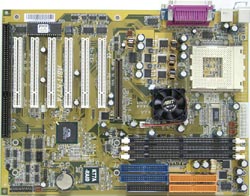
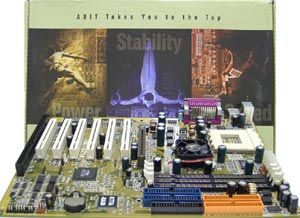 The most compact board, even among the boards with ATA/100-RAID. A good thought out design. The downside is one - a close placement of DIMMs and AGP slot. The board lacks for AC'97 Audio and AMR/CNR slot but it doesn't matter much since Abit products are mainly intended for overclockers. The north bridge is equipped with a heat sink with a fan. The circuit of voltage transformation has 8 capacitors of 2200 mf. Some of them are located too close to the socket what prevents installation of cylindrical fans (like Thermaltake Orb). As usual, all connectors have writings, and main and additional IDE connectors are painted different colors. EpoX 8KTA3+

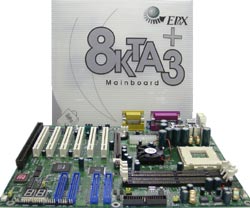 First of all, the board is shipped in untypical plastic box with a rope strap, though, reportedly, they started shipping the boards in a usual cardboard box. To some degree the 8KTA3+ is a twin of the previous KT7A-RAID, differing only in the 4th memory slot, sound subsystem and PCB's color. Nevertheless, there are some peculiar features such as an integrated PCI Debug Card - two digital indicators informing on the passing the POST test (Power-On Self Test). First, such indicators appeared 4 years ago on the TOTEM boards. But as a rule, for a full value POST-card with digital indicators manufacturers are looking for a cheaper substitute (for example, 4 LEDs like on the MSI boards) that's why it's quite pleasant that EPoX not only realized this function but also did it in corpore. Besides, the board features a possibility of installation of the backup BIOS chip, though it's optional. As for the layout, it's strange why the company places the power supply connector in the center of the board, it's very inconvenient for assemblers. Besides, the placement of DIMMs and the second connector of the external ATA/100-controller is not ideal - too close to the AGP slot. And the slot itself is made competently, it's even equipped with a clamp. The circuit of voltage transformation has 7 huge capacitors of 4700 mf which are too close to the socket, thus prevent installation of Orb coolers. The IDE connectors are located as an extension of PCI slots (athwart to the board's edge). Apparently, they wanted to decrease dimensions in order to eliminate problems with installation into small sized cases. The soldering quality is perfect, but the impression was spoiled due to some attached devices on the back side. A set for overclocking settings impresses: control of VCore, VIO, and even Vagp. The control of the multiplier (if it's unlocked) is done right from the BIOS. The board features everything necessary for an overclocker except for Vmem. Iwill KK266-R
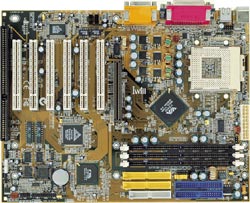 The board ships in a usual plastic box with a cut out window. A beautiful designer's solution when a disc is located above the board is not rational, the majority of uses prefer a CD in a paper envelope. Unlike the Iwill DVD266-R, this layout is competent. One of downsides is too close position of memory slots to the AGP slot. The PCB implementation and soldering are of high quality. The voltage transformation circuit contains 10 capacitors 5 of which are 1500 mf, the other are 2200 mf. Again due to close location of the capacitors to the socket the Orb-compatibility is absent. Soltek SL75KAV-X
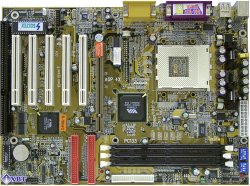
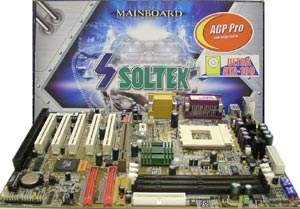 The board show quite good performance and stability. This company was first to decisively take VIA chipsets: in their roadmap the number of the boards on them is prevalent. Soltek still manages to produce boards on the latest VIA chipset much earlier than other OEMs. The SL75KAV-X is an extension of a quite successful SL75KV2/KV+ series. Nevertheless, the engineers redesigned the device a bit. Due to lack of the external ATA/100 the board is very small. On the whole the design is competent except for too close location of the second IDE connector to the AGP slot. The board features a multilanguage voice diagnostics, though the quality of speech output via a PC-speaker is nasty. Besides, there is a support of the Red Storm Overclocking technology allowing to overclock in "auto" mode. But I think that manual overclocking is better. Another interesting feature is control of Vmem what is really handy feature for an advanced overclocker. The voltage transformation circuit contains five 3300 mf capacitors and four 2200 mf ones. They are located quite far from the socket, that's why the board is Orb-compatible. The soldering is good. Interestingly that a sticker with a writing "UltraATA/100" is glued to the LPT-port connector :) ASUS A7V133
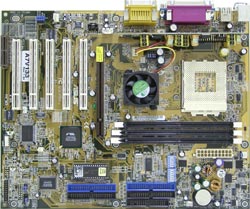
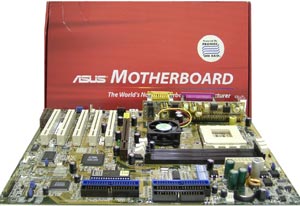 Despite a bit high price the products of this company are widely popular. Quality of the PCB always corresponds to high level, and the A7V133 is not an exception. The north bridge is equipped with an active heat sink. A part of the voltage transformation circuit which contains six 680 mf capacitors is brought onto the separate board (beside them there are two 1500 mf capacitors, one 820 and one 1000 mf). Due to such solution no problems with big coolers must arise. The multiplier and system bus frequency can be changed both in the BIOS and with dip-switches. All positions of jumpers and dip-switches are written right on the board. Here you can see a traditional table with features of the KT133A based boards:
Comments on the table:
AOpen AK73 Pro
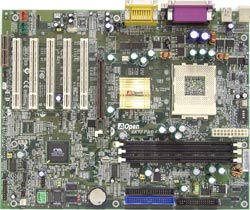
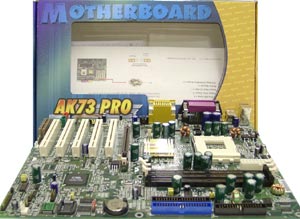 This board on the VIA KT133 chipset with 686B south bridge was tested beyond the competition, as a competitor against its more advanced brothers. AOpen produces high quality PCB (like Intel, SuperMicro, Tyan boards and some of Asus intended for OEM market), good performance, reliability, plus a moderate price. As for AOpen boards Acer company is oriented at the end user: beautiful box (plastic box and cardboard package with a cut-out), golden radiators, color PCBs (black, pink, rich green). Besides, the board is equipped with a detailed manual, a full set of cables and a huge colorful poster. The AOpen AK73 Pro is made in ATX format on the VIA KT133 chipset. Its design was developed with consideration of an upcoming KT133A chipset, and that's why it much differs from AK73 design. The board features an AGP 4x-slot with a holder (like on the EPoX board), the design allows usage of the AGP Pro connector. Three connectors for DIMM, each is suitable for a module up to 512 MBytes, are far enough from the AGP slot. The board has 5 PCI slots, AMR slot and AC'97 Audio (Analog Devices AD1885 codec). Two IDE- and one FDD-connector are located traditionally on the edge. Two COM ports and one LPT are on a usual for ATX-boards place. The AK73 Pro has a BIOS chip with AWARD 6.0 and an empty bed for the second chip. BIOS can control the installed IC-Works W230H generator changing the FSB frequency within 100-166 MHz in small steps. Besides, integrated functions of the system monitoring of the VIA 686B, south bridge are enabled what ensures control of CPU and system temperatures, voltage and fan rotation speed. The board requires insertion of the CPU's fan right into CPU_FAN connector (they are three), otherwise the system turns off in 5 sec (like in the Abit KT7A-RAID). The AK73 Pro allows changing CPU multiplier, as well as VIO and VCore (the first two options are available with dip-switches and jumpers). There is a voice diagnostics function. Apart from standard cables, the manual and a CD with software the complete set includes a poster (a shortened form of the manual), an additional UATA/66-100 cable, a bracket C 3 and 4 USB ports and a CD with Norton Antivirus. The voltage transformation circuit contains 6 1500 mf capacitors and two 3300 mf ones. The board is not "Orb-compatible". The PCB quality and soldering are perfect. Test system
We used the Win98SE Russian OS, VIA 4-in-1 4.28 driver pack, DirectX 8.0a. All tests were carried out in 1024X768 mode, HighColor, 85 Hz. TestingThe HDDs were installed on the Primary IDE channel, the Secondary IDE one was off. The sound subsystem installed on the board was also disabled. The memory ran in the PCICLK*4 mode with maximum speed settings including 4-way interleave mode. The software used:
The basic testing was held in the regular CPU mode (100*8), the more interesting 133*6 mode will be discussed later.
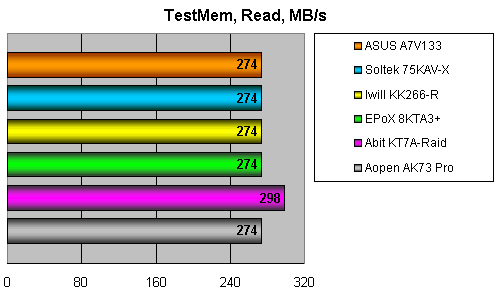
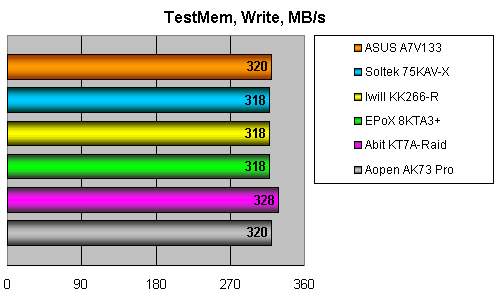
 Due to well developed BIOS features for memory the Abit board outpaced even the Soltek. Note that you can achieve such high performance level on other boards with WPCRedit in use by fine adjustment of some chipset functions hidden in BIOS. Bapco Sysmark 2000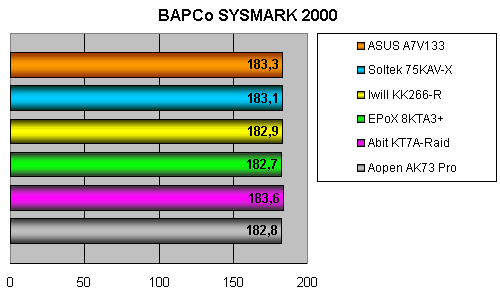 The performance is nearly identical. It's clear to see that the AOpen doesn't fall behind the contestants. 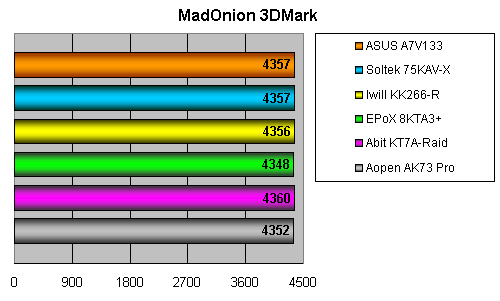 A vivid advantage of the Abit in CPU-memory speed test is "eaten up" in 3D. The AOpen (together with VIA KT133) doesn't not lag as well.
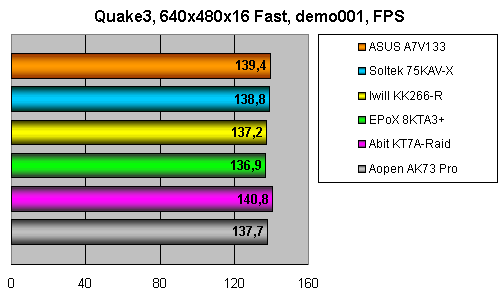
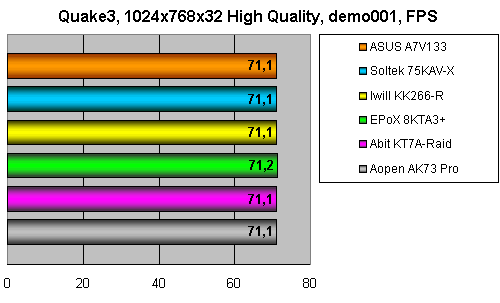 In the "Fastest" mode the situation is nearly the same as in the processor-memory tests. The program doesn't load hard the video card, and performance of the link "CPU-chipset-memory" is determinant. In HQ mode it's the 3D-accelerator performance that is determinant, and difference between the boards and the chipset disappear. OverclockingThe AMD Athlon Thunderbird 800, which works in 100X8 mode, with the voltage increase by 0.5-1 V worked stable at 930-940 MHz, failures started only in 100X9.5 mode. The Kingston Valueram memory, intended for CAS3 PC133 mode, performed well in CAS2 mode at the bus clock speed up to 157 MHz what was checked on the Abit BF6 motherboard with Pentium III Coppermine 733 with initially unlocked multiplier. So, overclocking can be determined by the memory or processor, and the limit was eventually set by motherboard features. Tests in non-standard mode were carried out in a softer configuration: with a video adapter and a sound card. It's connected with sharp decrease of the system stability with increase of the number of PCI-devices (for example, the Tekram K7KXA board loads Windows from the SCSI-disc at 120 MHz, and with 5 PCI-devices and the enabled IDE it doesn't switch on even at the 115 MHz). The majority of users would opt for the "safety" overclocking variant having installed the processor on the 133 MHz bus and decreased the multiplier. Below you can see results of measuring performance of the AMD Athlon Thunderbird 800 in two modes: 100X8 and 133X6.
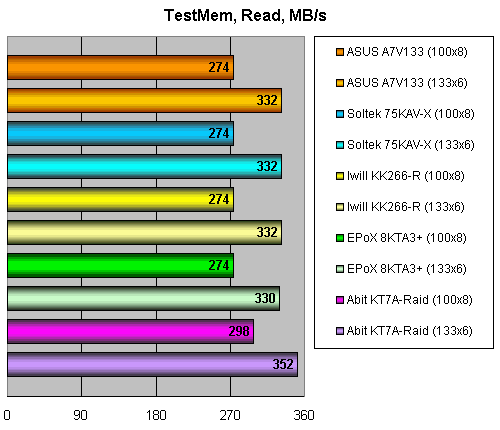

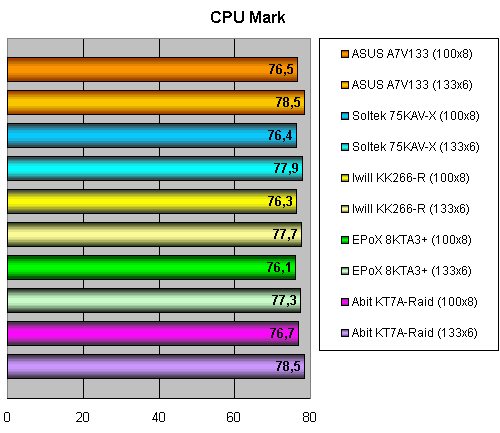
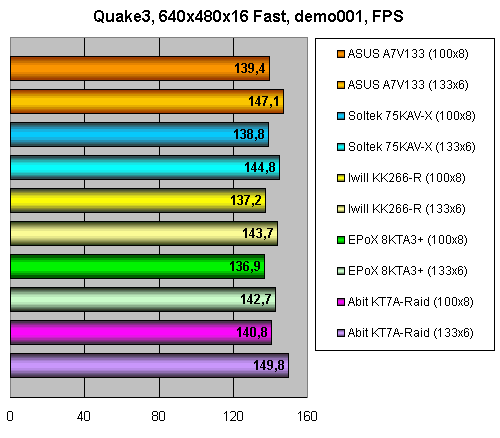 When testing by Quake III in HQ mode where the overall system performance is limited by the 3D-accelerator speed we noticed no difference. Below you can see a table of the max FSB frequencies which can be reached on each board without loss of reliability:
Due to impossibility to change FSB frequency in 1 MHz steps on the EPoX 8KTA3+ board we couldn't lift the clock speed more than 150 MHz (the next figure in list is 155 MHz). The Iwill board required a high quality power supply unit for operation in the mode with 133 MHz FSB and higher (I can recommend Lite-On or Delta). SummaryThere are certainly some advantages in case of the 133 MHz bus (266 MHz DDR). Nevertheless, performance increase in not very high, besides, overclocking by increasing the multiplier on the KT133 is sometimes not less efficient. That's why I can't recommend you to replace the KT133 by the KT133A, everything depends on money. However, for a new computer the VIA Apollo KT133A chipset will still be better in terms of price/performance correlation, considering that the boards based on it cost just a bit more than KT133. Note that it is a baffling problem to mark out a leader among the KT133A boards, that's why I will just describe the noticeable features of each board: Abit KT7A-RAIDThe junior sister of the Abit KT7 (perhaps the only board for a competent overclocking). The board showed not only high performance and a plenty of settings but also a high stability in the course of overclocking and compatibility with different PCI-equipment. EpoX 8KTA3+The quality of implementation corresponds to a very high level. On the whole, everything is quite good - equipment, functionality (including overclockability). In the tests, however, the board is slower than the competitors, and I failed to reach the maximum bus frequency due to lack of intermediate values between 150 and 155 MHz of FSB. On the other hand, the PCI Debug Card support makes this card an excellent tool in the hands of brave experimenters. It's easy to define what caused failure while overclocking due to displaying of POST-codes in the course of initialization of the devices. Iwill KK266-RA good board from the manufacturer who pays special attention to the quality of their products. The Iwill boards are not cheap, but it's outweighed by high stability and good performance. I can recommend it in case you need ATA/100 RAID, since IDE RAID-controller from AMI (in fact, a remarked CMD chip) provides the maximum performance and convenience in this mode. The only downside is troubles in case of grey power supply units. Soltek SL75KAV-XA good and fast board with high performance and rich overclocking possibiities, and with low price. I think that it's a leader in terms of the correlation of price, performance and functionality. ASUS A7V133High performance together with high price is typical for ASUS. The A7V133 is a good choice for a ASUS fan since it doesn't differ from other ASUS products. Besides, you should note that ATA/100 IDE RAID-controller is realized on the Promise's chip which has no such reputation as the HighPoint products do (which are often blamed for instability and incompatibility with some models of HDDs). AOpen AK73 Pro
A simple quality board on an aging chipset, which is still capable to compete
against the latest products in a standard mode. Considering the quality
of implementation and rich complete set it can be recommended to those
who are not looking for super high performance but prefer quality and stability
at the moderate price. Write a comment below. No registration needed!
|
Platform · Video · Multimedia · Mobile · Other || About us & Privacy policy · Twitter · Facebook Copyright © Byrds Research & Publishing, Ltd., 1997–2011. All rights reserved. | ||||||||||||||||||||||||||||||||||||||||||||||||||||||||||||||||||||||||||||||||||||||||||||||||||||||||||||||||||||||||||||||||||||||||||||||||||||||||||||||||||||||||||||||||||||||||||||||||||||||||||||||||||||||||||